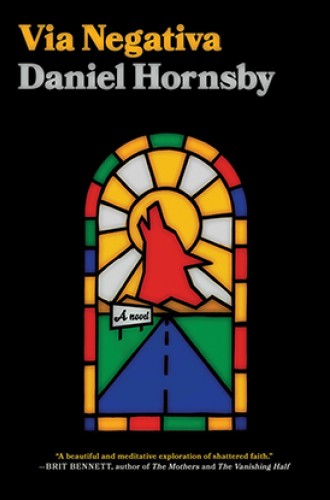Journeying with Father Dan and a coyote along the via negativa
Daniel Hornsby’s debut novel has a wonderful road-trippy feeling.
In the first paragraph of Daniel Hornsby’s debut novel, the main character, a retired and homeless Catholic priest, watches a coyote struck by a minivan fly off to the side of the road, “a gold smudge.” Father Dan stops to take the coyote into his car, names him Bede after the Venerable Bede, and goes to seek medical care for the wounded animal.
This is the first sign that Father Dan’s road trip will be weird. The via negativa (negative way) in question is the literal road between Indiana and Washington State, where Father Dan is headed because he doesn’t know where else to go. Despite the fact that he is carrying a personal library that includes Bede’s homilies and the collected works of Origen, he seems to be discarding his faith as he goes. His aimless path includes such national treasures as the world’s largest ball of paint and a world-famous bottomless pit.
Father Dan blames the spiritual via negativa for the way that his life has devolved. His fascination with The Cloud of Unknowing led to a reading list—“the writings of Dionysius the Areopagite, the Spiritual Exercises of St. Ignatius, Thomas Merton, Simone Weil, Julian of Norwich.” This fascination, he claims, is “at the root of why I no longer live at the rectory, why I now live in a Toyota Camry.” He gradually disengaged from the religious institution that sponsored his life and gave him a job. In the end, the two could no longer coexist.
Father Dan is not only a potential mystic but also a cultural critic with a keen eye for what makes America strange. As he drives past Jesus statue after Jesus statue, he reflects, “My country is a bad church. A church of itself.” He muses about the “oddly medieval” nature of roadside attractions like the bottomless pit:
They are the great- (great-great-great, etc.) grandchildren of the enterprising shrines along the old vias, peddling their relics to high-speed pilgrims, telling them they have only to stop for a while to stick their feet in the strange currents of mystery. I’d been tempted by a few already—a giant concrete prairie dog, a hall of fame for greyhound racers—but this one, with its small gesture toward the infinite, I couldn’t resist.
Perhaps I shouldn’t have been surprised that a book entitled Via Negativa doesn’t move Father Dan forward in his spiritual struggle, but I found myself waiting for him to make some kind of pilgrim’s progress. Hornsby graduated from Harvard Divinity School, and one of the many pleasures of this novel is the fact that he is well steeped in the Christian contemplative tradition. He uses that knowledge deftly to take Father Dan’s dilemma seriously, but not too seriously.
At the same time, Father Dan does not find a path greater than the one that has flung him out on the road. The church whose hierarchy badly let him down still dictates the culture and the future. After some particularly troubling revelations, Father Dan says, “I decided it was my role to remain on the edge of the outside of things.”
This would be an apt starting place for Father Dan, but as an ending place, it seems incomplete. John of the Cross, one of the first Christians to articulate the via negativa, sees the dark night of the soul as ultimately a path to joy. For Father Dan, that does not seem to be the case.
Even so, the book has a wonderful road-trippy feeling. There is a just-right-ness about it: just enough road trip, just enough backstory, just the right number of episodes and encounters, and all together enough quirkiness to make the whole experience worth going on the road.
One of my favorite scenes involves Father Dan and one of his traveling companions helping paint the world’s largest ball of paint. At the bottomless pit, there’s nothing to do but stare into it. But with the ball of paint, visitors can participate. “You have to do a whole coat,” the proprietor says. “That’s the deal.” It’s a roadside attraction that is self-perpetuating. The more that visitors add paint, the larger it grows. The larger it grows, the more something of value, however strange, appears.
It seems like a bit of religious commentary: when we get involved, something happens. It might be weird, it might lead us where we don’t want to go, but through creativity and participation, we can make something together, even “on the edge of the outside of things.”
Father Dan and his traveling companion find a momentary satisfaction in participating in the painting of the world’s largest ball of paint, but can this short-lived satisfaction become joy? Can Father Dan continue on the via negativa and find what John of the Cross found? The novel ends with the sense that the mystical road is not finished with Father Dan yet. Where it leads, we still don’t know.






